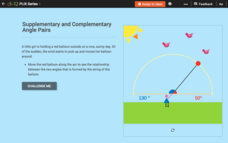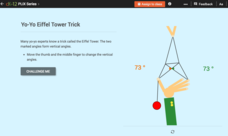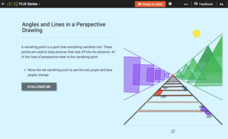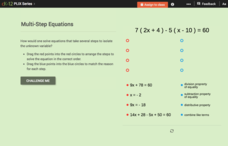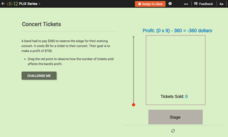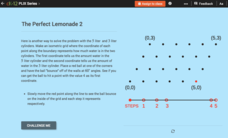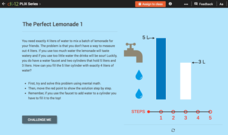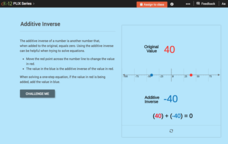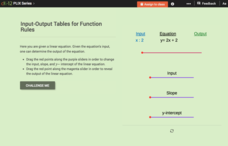CK-12 Foundation
Polygon Classification
Polly want a polygon? Young mathematicians sort shapes using an interactive. They classify the shapes as convex polygons, concave polygons, or not polygons.
CK-12 Foundation
Supplementary and Complementary Angle Pairs
Complement and supplement your knowledge of angles. Young mathematicians study supplementary and complementary angle pairs using an interactive. A set of challenge questions solidifies this understanding.
CK-12 Foundation
Vertical Angles: Yo-Yo Eiffel Tower Trick
Yo, yo, learn about vertical angles with a yo-yo. Using an interactive, scholars adjust the position of fingers holding a design from a yo-yo. Answering a set of challenge questions based on the interactive helps clarify understanding of...
CK-12 Foundation
Vertical Angles
Examine vertical angles from a different angle. Moving one line in an intersecting pair of lines lets users see relationships between vertical angles. They finish by answering some machine-scored questions on the topic.
CK-12 Foundation
Linear Pairs: Angles and Lines in a Perspective Drawing
Gain some perspective on linear pairs. Aspiring mathematicians adjust the vanishing point on a perspective drawing. They see the effect on linear pairs of angles and answer five challenge questions based on their observations.
CK-12 Foundation
Linear Pairs
Pair up this resource with a lesson on linear pairs. Scholars solve for missing variables and values of angles in linear pairs. They use an interactive to help with this endeavor.
CK-12 Foundation
Supplementary Angles: Spiderweb Angles
The itsy, bitsy spider went up the virtual wall. An interactive allows users to change the angles in a spider web. They must attend to supplementary angles as they answer challenge questions throughout the interactive.
CK-12 Foundation
Complementary Angles: Corner Kick
Soccer is all about angles. Young mathematicians use an interactive to correctly position the path of a soccer ball so that it reaches the goal. They consider complementary angles when answering a set of challenge questions.
CK-12 Foundation
Complementary Angles
Here's an interactive that complements your lesson plans. Users of the resource adjust one of the angles in a complementary set to see how it affects the other. A set of challenge questions assesses understanding.
CK-12 Foundation
Angle Pairs: Angle Measurements
As one changes, so does the other. Scholars use an interactive to see how changes in the measure of one angle of a complementary or supplementary pair of angles affect the measure of the other angle. They answer a set of challenge...
CK-12 Foundation
Multi-Step Equations
It's important to know why each step in solving an equation works. Scholars order the steps and reasons when solving a multi-step equation. Solutions require using the distributive property, combining like terms, and using properties of...
CK-12 Foundation
Multi-Step Equations with Like Terms: Shipments
Who doesn't like boxes of money? A drag-and-drop interactive lets users separate variables and constants to combine like terms. They answer a set of challenge questions based on the results of the interactive.
CK-12 Foundation
Two-Step Equations with Subtraction and Multiplication: Cupcake Equation
Solving equations is a piece of cake. Young mathematicians use an interactive to create a bar model to representing a situation involving cupcakes. They use the model to solve for the cost of a cupcake.
CK-12 Foundation
Two-Step Equations with Addition and Multiplication: T-Shirt Equation
Interactive bar models make solving equations fairly easy. Scholars use an interactive to adjust a bar model representing an equation. This model helps solve the equation.
CK-12 Foundation
Equations with Variables on Both Sides: Rubber Ducky Math
Rubber ducky, you're the one ... to help solve equations. Young mathematicians use an interactive to set up a situation involving rubber ducks. This helps users visualize and solve an equation with variables on both sides.
CK-12 Foundation
Solving Real-World Problems Using Multi-Step Equations: Bowling Ball Delivery
How many bowling balls can a truck carry? A slider interactive changes the weight of boxes and the number of bowling balls per box. Investigating with this slider lets users find the maximum number of bowling balls.
CK-12 Foundation
Linear Inequalities: Concert Tickets
Profit from this resource on linear inequalities. A slider interactive lets users see how the profit on band ticket sales changes with the number of tickets. A set of challenge questions provides some situations for learners to consider.
CK-12 Foundation
Problem Solving Plan, Mental Math: The Perfect Lemonade 2
Drink in this resource. Young problem solvers investigate a different way of looking at the problem of filling four liters of water from a three-liter cylinder and a five-liter cylinder. Isometric grids help with this understanding.
CK-12 Foundation
Problem Solving Plan, Mental Math: The Perfect Lemonade 1
Find the perfect amount of water for lemonade. Scholars solve the famous problem of measuring four liters of water using a three-liter container and a five-liter container. An interactive allows users to see each step of the solution.
CK-12 Foundation
Applications Using Linear Models: Scuba Diving
Dive into this resource on rates of change and linear models. Pupils use two sliders in an interactive to adjust water temperature and depth. They use a given linear equation to calculate the rate of change in water temperature per unit...
Consortium for Ocean Leadership
Measure for Measure
How does your class measure up? Young scientists create a scale drawing of the JOIDES Resolution in a collaborative activity. The lesson incorporates mathematical principles with deep-sea exploration to focus on enhancing measurement...
CK-12 Foundation
One-Step Equations and Inverse Operations: Additive Inverse
Reinforce properties while solving equations. Learners often ignore properties even as they try to apply them. A well-designed lesson emphasizes the role of additive inverses when solving equations.
CK-12 Foundation
Input-Output Tables for Function Rules
Make the abstract a bit more concrete with an interactive that asks learners to slide an input value through a function to determine the output. Changing the slope and y-intercept allows them to see the how the output values change.
CK-12 Foundation
Input-Output Tables for Function Rules
How does changing a graph affect the function? Learners watch the changing input-output table as they adjust the location of the line graph. Questions prompt them to complete a table of values and determine the function rule.

